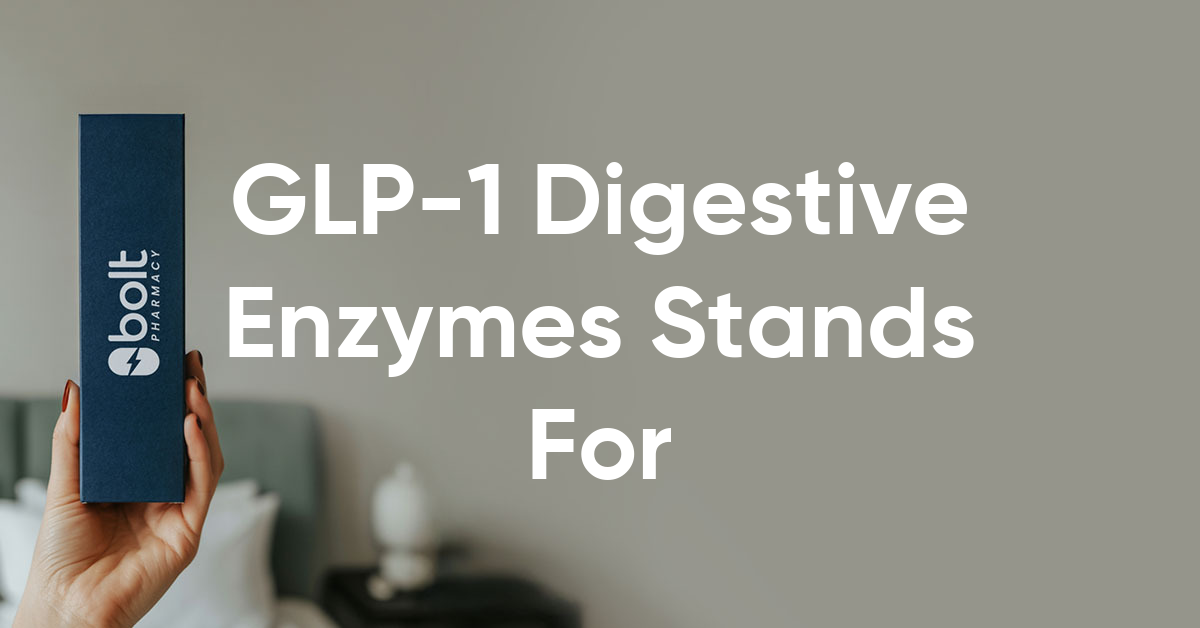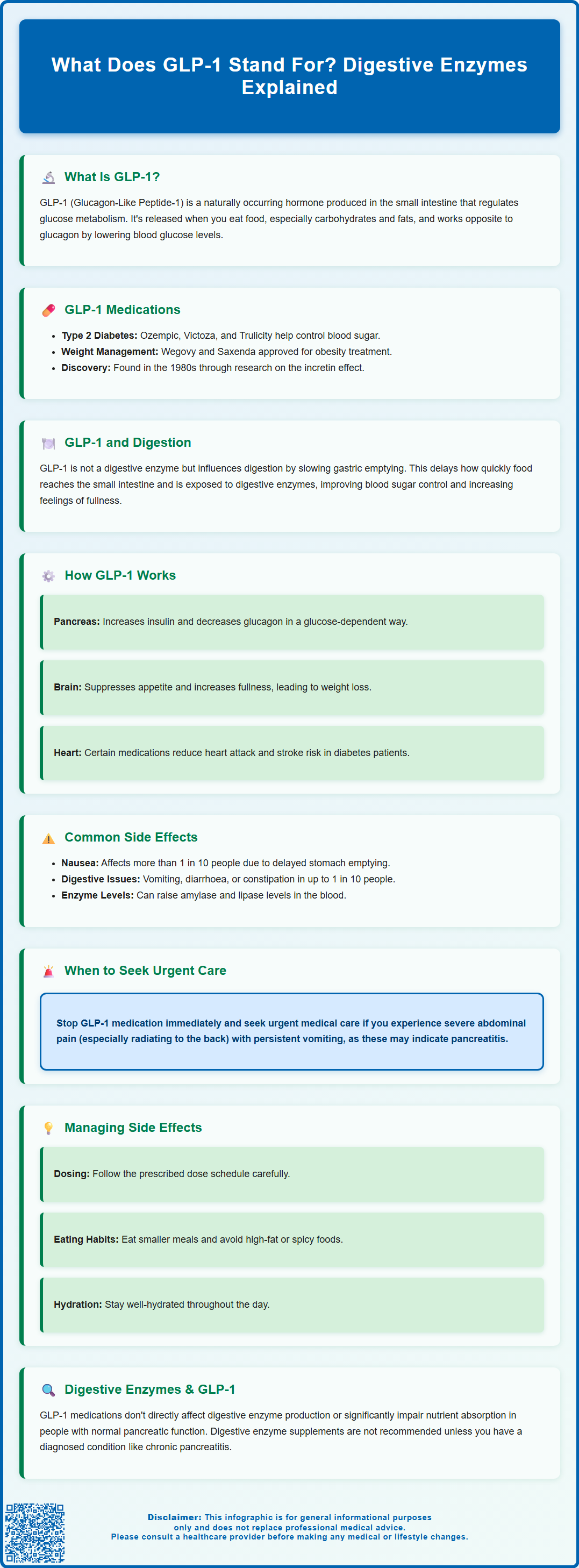Mounjaro®
Dual-agonist support that helps curb appetite, hunger, and cravings to drive substantial, sustained weight loss.
- ~22.5% average body weight loss
- Significant weight reduction
- Improves blood sugar levels
- Clinically proven weight loss

GLP-1 stands for Glucagon-Like Peptide-1, a naturally occurring hormone produced in the small intestine that plays a vital role in glucose metabolism and appetite regulation. This incretin hormone has revolutionised the treatment of type 2 diabetes and obesity in the UK, with MHRA-approved medications such as semaglutide and liraglutide now widely prescribed. Whilst GLP-1 is not a digestive enzyme itself, it significantly influences digestive processes by slowing gastric emptying and affecting pancreatic function. Understanding what GLP-1 stands for and how it works helps patients and healthcare professionals optimise diabetes management and weight loss treatments whilst managing potential gastrointestinal side effects.
Summary: GLP-1 stands for Glucagon-Like Peptide-1, a hormone produced in the small intestine that regulates blood glucose and appetite.
GLP-1 stands for Glucagon-Like Peptide-1, a naturally occurring hormone produced primarily in the L-cells of the small intestine, particularly in the ileum and colon. This incretin hormone plays a crucial role in glucose metabolism and has become increasingly important in modern diabetes management and weight loss treatments.
GLP-1 belongs to a family of peptide hormones that are released in response to food intake, particularly when nutrients—especially carbohydrates and fats—enter the digestive tract. The hormone was first identified in the 1980s when researchers discovered that oral glucose intake stimulated more insulin release than intravenous glucose administration, a phenomenon known as the incretin effect. This observation led to the identification of GLP-1 as one of the key incretin hormones responsible for this enhanced insulin response.
In clinical practice, understanding GLP-1 has revolutionised the treatment of type 2 diabetes mellitus and obesity. The Medicines and Healthcare products Regulatory Agency (MHRA) has approved several GLP-1 receptor agonists that activate the GLP-1 receptor. For type 2 diabetes, these include semaglutide (Ozempic), liraglutide (Victoza), and dulaglutide (Trulicity). For weight management, semaglutide (Wegovy) and liraglutide (Saxenda) are licensed.
The term 'glucagon-like' refers to the hormone's structural similarity to glucagon, another pancreatic hormone, though GLP-1 has distinctly different physiological effects. Whilst glucagon raises blood glucose levels, GLP-1 helps lower them, demonstrating the complex regulatory mechanisms governing glucose homeostasis in the human body.
The relationship between GLP-1 and digestive enzymes is indirect but functionally significant within the broader context of gastrointestinal physiology. GLP-1 itself is not a digestive enzyme, nor does it directly produce digestive enzymes. However, it profoundly influences the digestive process through its effects on gastric emptying and pancreatic function.
Digestive enzymes—including amylase, lipase, and proteases—are produced by the pancreas and released into the small intestine to break down carbohydrates, fats, and proteins respectively. GLP-1 affects the pancreatic secretion of insulin from beta cells, which indirectly influences the overall metabolic environment in which digestion occurs. When GLP-1 levels rise after eating, the hormone stimulates insulin secretion in a glucose-dependent manner, meaning insulin is only released when blood glucose levels are elevated.
One of GLP-1's most clinically relevant effects on digestion is its ability to slow gastric emptying. By delaying the rate at which food leaves the stomach and enters the small intestine, GLP-1 effectively moderates the speed at which nutrients are exposed to digestive enzymes. This slowing effect contributes to improved glycaemic control and increased satiety—the feeling of fullness that helps reduce food intake.
Patients taking GLP-1 receptor agonists commonly report gastrointestinal side effects, including nausea, vomiting, diarrhoea, and constipation. These effects are largely attributable to the medication's impact on gastric motility. While there is no direct evidence that GLP-1 medications impair routine digestive enzyme production, it's important to note that GLP-1 receptor agonists can increase serum amylase and lipase levels and have been associated with rare cases of acute pancreatitis. Patients should stop taking their GLP-1 medication and seek urgent medical attention if they experience severe abdominal pain (especially if radiating to the back) with persistent vomiting, as these may be signs of pancreatitis.

Do GLP-1 medications affect digestive enzyme production? Current evidence does not indicate that GLP-1 receptor agonists directly inhibit or enhance the routine production of digestive enzymes. The pancreas continues to produce amylase, lipase, and proteases normally. However, because these medications slow gastric emptying, the timing and rate at which food is exposed to digestive enzymes may be altered, potentially affecting the digestive experience.
Why do GLP-1 medications cause digestive symptoms? The gastrointestinal side effects associated with GLP-1 receptor agonists primarily result from delayed gastric emptying and altered gut motility. According to product SmPCs, nausea is very common (affecting more than 1 in 10 people), while vomiting and diarrhoea are common (affecting up to 1 in 10 people). These symptoms typically improve over time as the body adapts to the medication. To minimise these effects, follow the prescribed dose titration schedule, eat smaller meals, avoid high-fat or spicy foods, and stay well-hydrated.
Should I take digestive enzyme supplements with GLP-1 medications? There is currently no clinical evidence supporting the routine use of digestive enzyme supplements alongside GLP-1 receptor agonists. Unless you have a diagnosed condition affecting enzyme production (such as chronic pancreatitis or pancreatic insufficiency), additional enzymes are unlikely to provide benefit and should not be self-prescribed. If you experience persistent digestive discomfort whilst taking GLP-1 medications, consult your GP or diabetes specialist.
Can GLP-1 medications affect nutrient absorption? Whilst GLP-1 receptor agonists slow the digestive process, there is no substantial evidence that they significantly impair nutrient absorption in individuals with normal pancreatic function. However, the medications' effects on appetite and food intake may lead to reduced overall nutrient consumption, which is actually part of their intended mechanism for weight management. Patients should maintain a balanced diet and discuss any nutritional concerns with their healthcare provider. Note that the risk of hypoglycaemia is low when GLP-1 receptor agonists are used alone but increases when combined with insulin or sulfonylureas.
GLP-1 exerts its effects through binding to GLP-1 receptors located throughout the body, including the pancreas, brain, heart, kidneys, and gastrointestinal tract. This widespread receptor distribution explains the hormone's diverse physiological effects beyond glucose regulation.
In the pancreas, GLP-1 stimulates insulin secretion from beta cells in a glucose-dependent manner—a crucial safety feature that reduces the risk of hypoglycaemia (dangerously low blood sugar). Simultaneously, GLP-1 suppresses glucagon secretion from alpha cells, further contributing to improved glycaemic control. This dual action helps maintain blood glucose within the normal range, particularly after meals when glucose levels naturally rise.
The hormone's effects on the central nervous system are equally important. GLP-1 receptors in the hypothalamus and brainstem mediate appetite suppression and increased satiety, contributing to reduced food intake and weight loss. This mechanism has led to NICE recommendations for certain GLP-1 receptor agonists for weight management in individuals with obesity, even without diabetes.
Naturally produced GLP-1 has a very short half-life of approximately 2–3 minutes because it is rapidly degraded by the enzyme dipeptidyl peptidase-4 (DPP-4). This rapid breakdown necessitated the development of modified GLP-1 receptor agonists that resist enzymatic degradation, allowing for once-daily or even once-weekly administration. It's worth noting that NICE guidance (NG28) advises against combining GLP-1 receptor agonists with DPP-4 inhibitors.
Cardiovascular benefits have emerged as an important aspect of GLP-1 therapy. Clinical trials have demonstrated that certain GLP-1 receptor agonists reduce the risk of major adverse cardiovascular events in patients with type 2 diabetes and established cardiovascular disease. These benefits are described in the Summary of Product Characteristics (SmPCs) for these medications.
Patients prescribed GLP-1 receptor agonists should be aware of potential side effects. If you experience severe abdominal pain (especially if radiating to the back), persistent vomiting, or other concerning symptoms, stop taking the medication and seek urgent medical attention. Suspected side effects can be reported through the MHRA Yellow Card scheme.
GLP-1 stands for Glucagon-Like Peptide-1, a naturally occurring incretin hormone produced in the small intestine that regulates blood glucose levels and appetite. It is structurally similar to glucagon but has opposite effects, helping to lower blood glucose rather than raise it.
No, GLP-1 is not a digestive enzyme but a hormone that influences digestive processes. It slows gastric emptying and affects pancreatic insulin secretion, indirectly impacting how nutrients are exposed to digestive enzymes in the small intestine.
No, there is no clinical evidence supporting routine digestive enzyme supplementation with GLP-1 receptor agonists. Unless you have a diagnosed condition affecting enzyme production, additional enzymes are unlikely to provide benefit and should not be self-prescribed.
The health-related content published on this site is based on credible scientific sources and is periodically reviewed to ensure accuracy and relevance. Although we aim to reflect the most current medical knowledge, the material is meant for general education and awareness only.
The information on this site is not a substitute for professional medical advice. For any health concerns, please speak with a qualified medical professional. By using this information, you acknowledge responsibility for any decisions made and understand we are not liable for any consequences that may result.
Lorem ipsum dolor sit amet, consectetur adipiscing elit, sed do eiusmod tempor incididunt ut labore et dolore magna aliqua. Ut enim ad minim veniam, quis nostrud exercitation ullamco laboris nisi ut aliquip ex ea commodo consequat. Duis aute irure dolor in reprehenderit in voluptate velit esse cillum dolore eu fugiat nulla pariatur.
Block quote
Ordered list
Unordered list
Bold text
Emphasis
Superscript
Subscript